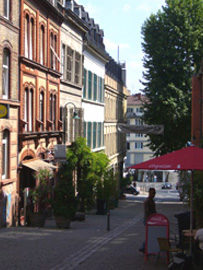Bergkirche District
In 1809, low-cost housing for lower income earners began to be created in Nerostraße, out of the sight of wealthy guests. For this reason the buildings erected were very plain, single-storey structures.
The buildings constructed between 1808 and 1811 were referred to popularly as "cat holes".
When thanks to poor construction and the increasing migration of small farmers into the city the Bergkirche District was on the brink of becoming the city's poorhouse, a resolution of the Duke provided the basis for efforts to make structural and design improvements.
As was the case for other historical buildings and districts, in the 60s the Bergkirche area was threatened with demolition. But the European Architectural Heritage Year 1975 saved the historical structures. Today, the district shows the results of outstanding reconstruction work.
When thanks to poor construction and the increasing migration of small farmers into the city the Bergkirche District was on the brink of becoming the city's poorhouse, a resolution of the Duke provided the basis for efforts to make structural and design improvements.
As was the case for other historical buildings and districts, in the 60s the Bergkirche area was threatened with demolition. But the European Architectural Heritage Year 1975 saved the historical structures. Today, the district shows the results of outstanding reconstruction work.



